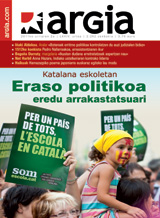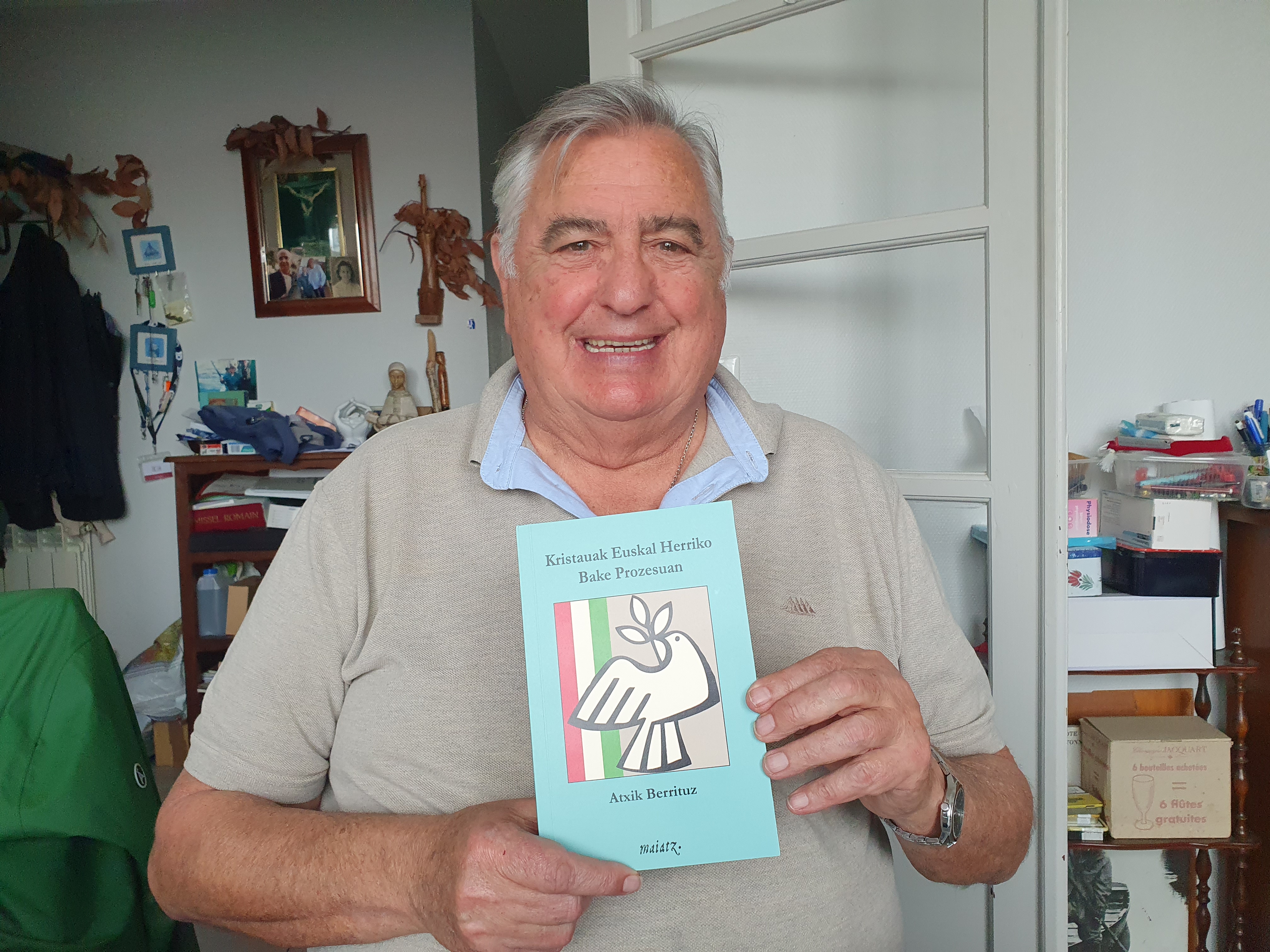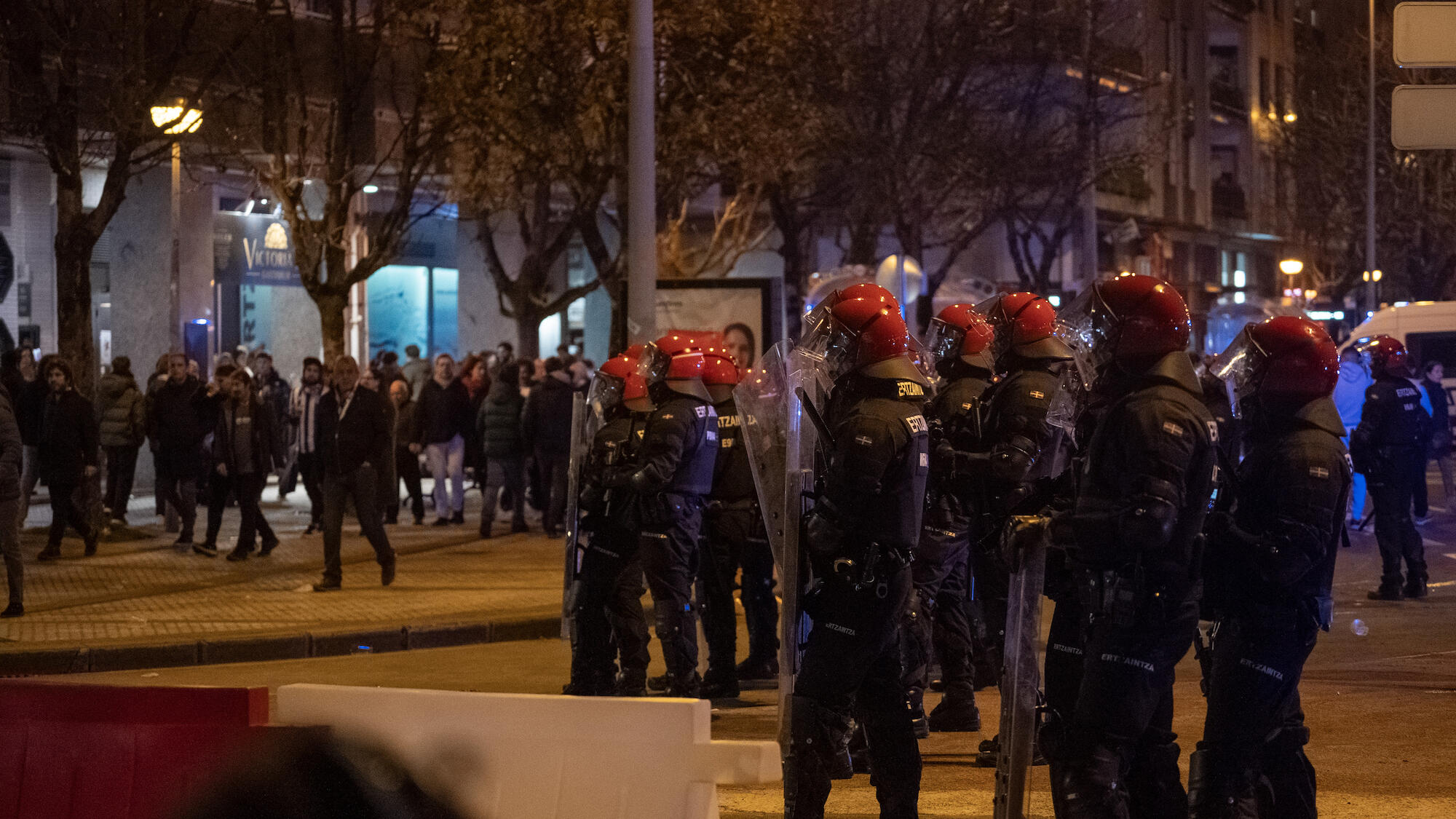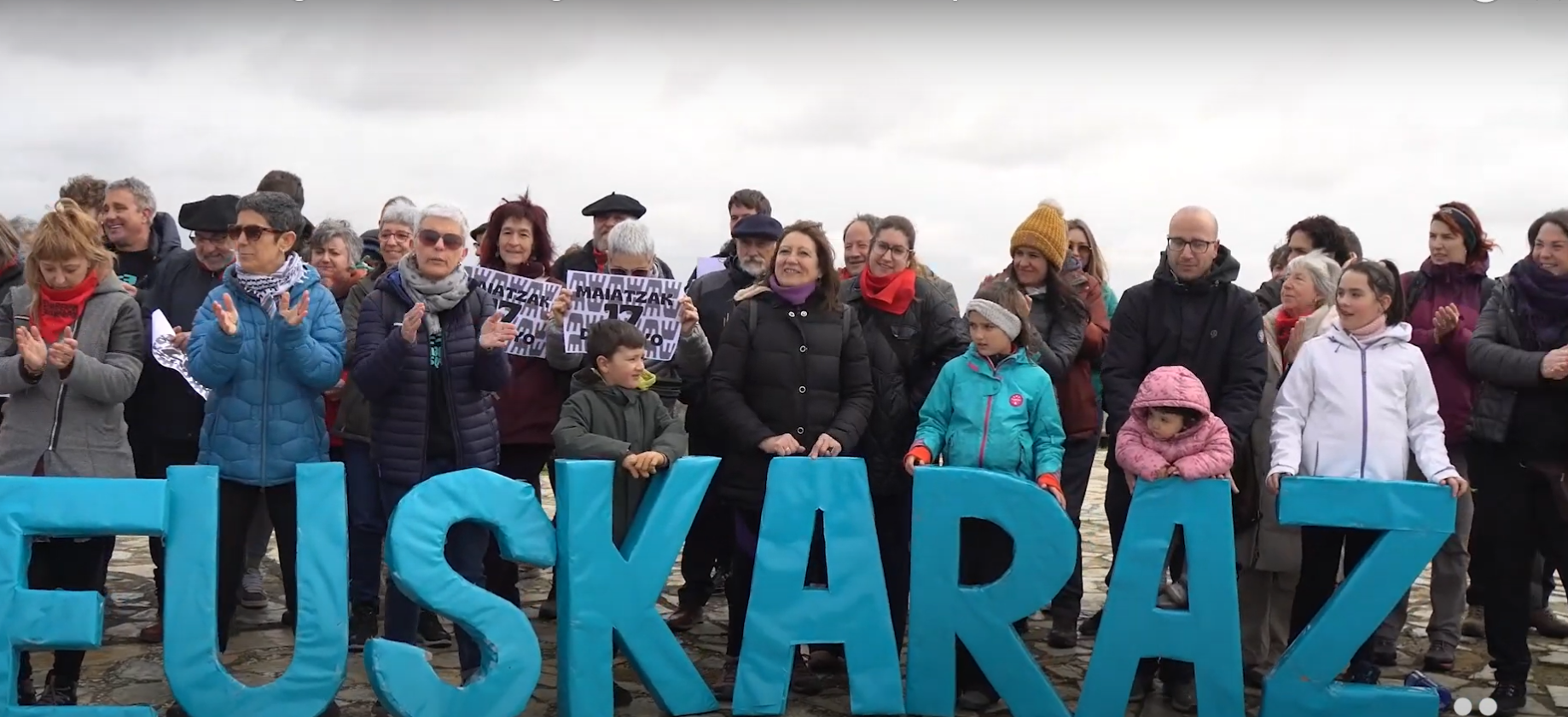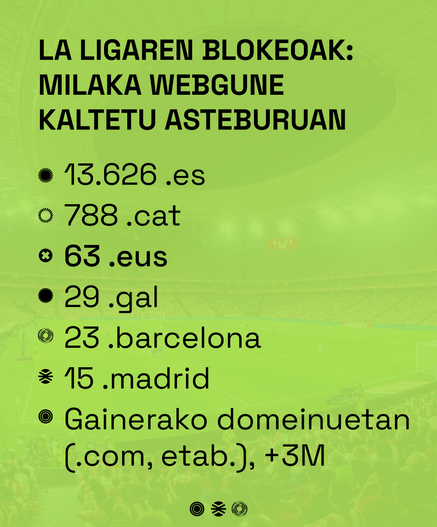"People didn't know I was painting it and I didn't know it either!
- Before summer to the bookstore. This one and the other. Seeking readings for oneself and for another. In that there was a great book, unbeatable to the little girl. Michel marriau. Author: Begoña Durruty. Writer, illustrator. And who is Begoña Durruty? You’ve launched yourself to search…

You are a painter, especially, but I have heard of his existence because he has written and illustrated the book.
That has been the case, nothing else. I do not consider myself a writer. He could be a bad writer. I consider myself a cartoonist or a painter, a sketch.
Anyway, you're also the author of the book.
I've put an image to the story. When I discovered the story, I was astonished. It was extraordinarily beautiful! At home we have always walked with the motto: Amapola marriau / cats this jain / gérer or today / kor, kor, kor, kor / kor, kor, kor, kor, kor, kor, kor, kor, kor, kor. I immediately felt that unknown tale so familiar. The work of Jose Mari Satrustegi was worth it. This is how the illustrations were made, three or four years after the reading of history, because I did not dare to make those illustrations on that occasion! I've always liked to draw, but one is to draw, and one is to illustrate a concrete text. As I said Astion, I did not dare to do it, I did not see myself capable of doing it. Then I had the scholarship of the Galtzagorri association to participate with other illustrators in a workshop in Arteleku [Marrazioak 1, 2009] and I saw how other illustrators work. Besides the illustrators, there were Harkaitz Cano and Ignasi Blanch, and they also helped me a lot. Because I had a nice story to tell, I cheered on and did, wrote and illustrated. And I've been lucky, because the publisher Erein has been in charge of publishing the book this year, Mitxitxi marriau.
You already have some other text before.
There's always something, yes. It's touched me by a friend who wants to tell something, who has written, and who has asked me for help in making illustrations, because I fix them very well by drawing. I have done a couple of works of this kind, to put it mildly, to put it mildly. I'm a little embarrassed to show it to you. However, I do not regret it, they have served me to learn the trade. But this work is now something else...
As a painter, do you have to link your mission to a specific text?
Tie him up? That also helps. Instead of starting from scratch, you have where to start, where to take... I've always liked the drawings that come from the books, and when I make this book, I've had nothing to do with it, nothing less than freedom. I illustrate the book freely.
What do you have to paint?
The need for communication, the inner worm… I don’t know what pushes me to paint, but there is always need, yes. You also paint to tell it, you rarely know it. I have the habit of seeing something, being attentive to something and drawing on a paper. I have a lot of drawings made like this. Then I come home and work. I started from those lines, and I kept playing without knowing what's going to happen. That's what I do, I have fun.
“Not knowing what’s going to come.”
Well, in front of you you have a drawing that told you something. You don't start from any line, you have someone who has caught your attention, you have the idea. Then the conversation begins, the conversation with the box. Tararino. When the painting calms down, it's over, the conversation is over... It's a distraction through drawing. I made the first paintings and looked around me. And here, because most artists are landscape architects, I went with them. José Mari Apezetxea, Tomás Sobrino… I began to make landscapes in his soul. Then, when I got bored, I started doing something else -- human bodies, houses, house furniture, animals -- I've played with everyone, I've also played with the techniques.
El Cura, Nephew… They're landscaped in the Baztan.
They are and have been so many landscapers, in the Baztan Valley yes. Because the place is very nice, can it be? The rope is long. At first Javier Ziga, then Jose Mari Apezetxea, Ana Mari Marin… With the latter two, the Biscayan Ismael Fidalgo came here to do the military service. I have a little picture of Fidalgo. When he saw an exposition of me, he wanted to change a piece. You may know the story of Fidalgo, a man of saltsero. I think when he was here, a group of young painters met in the Baztan Valley. I think that from time to time Menchu Gal and Oteiza himself came… Then came Thomas Sobrino, who was Kepa Arizmendi and Xabier Soubelet to the cry of Apezetxea. And the rope is not exhausted yet. Now we also have a small group and we meet from time to time to paint outside.
You, for your part, got bored of the cute.
I don't care about continuing with the landscape, but I also want to do other, different things. Or make landscapes, but in a different way. Always playing. After all, I want to treat the landscape differently. For example, bringing the reflexes you see into the picture, although with reality it has nothing to do with it. It's a landscape, though. But I get bored to see the landscape and portray what I see. I know what it is, landscape!
People like that, the landscape!
Yes, yes. And if it's autumn, better! Ha, ha, ha. The landscape is nice, but not only that. I look for something else inside… As our Mikel [Laboa] sang, I love fog: “That’s when I start to see the wonderful corners that light up inside myself.” Cube, cube, cube…
Oils, engravings, paintings… You have tried different molds.
I am playing with the texture, with the material… Seeing that each one offers different possibilities, so I dedicate myself to playing. I started making prints, for example, when I met another artist who lives in Arraioz. Lola Sarratea. We became friends and stayed there for a summer; I went home and she taught me. Now I have it parked, but one thing I really like is recorded. The engraving is nice. Before you start, you’re not sure what’s going to come out, it surprises you… Also to get up, the prints, they’re all papers and can be put in a drawer. Instead, the paintings… I would make some amazing paintings, but then you have to put them somewhere!
On the web begonadurruty.com you have many of your jobs, but you see them in your house and they have another look…
You have to see the works of art live, both my own and those of others. You can see and make an idea on the web. I even touch the pictures! In an exhibition, if there's no one watching, I touch them.
You have ease to draw.
I'm drawing it from the tartlar, from the little one. At school, I was always there, on Mars, drawing. I have that memory, the school books and the drawings that everyone had. But I started drawing late, really, about a dozen years ago, after the kids grew up. I once tried the oil and loved it. So I started. I wanted to learn Fine Arts from small to small. Always Fine Arts and Fine Arts. At home: “What are you going to do with these sketches?” Isn't it normal for them to react? I, too, would not have paid attention to my daughters! When my family grew up, worked and delivered me a little, I picked up the oil. I didn't try it until twelve years ago. He draws so much, but always with wax, with pencils, with everything… He always spent the time, the work he liked, the fun. I didn't even make anything red. In school, take notes and make drawings, cartoons of the faculty, and whatever.
You have become a painter without the help of the family.
At home, they didn't want to. In 2002, I took part in a summer course. The priest and Nephew were his teachers. Then, at any time, I went to see Joxe Mari. And Thomas Nephew has always been there. I've had the help of these two, but in school, I haven't had anyone to push my work forward. I said that I was always thinking about Fine Arts, but on the other hand, I was very sporty, and at home I was taken away from that desire to learn Fine Arts. Then I learned that the SHEE [Basque Institute of Physical Education] existed in Vitoria, I went and learned. I'm from the second promotion. It was said that I would be a professor and I did, and I've been a professor. He always told me that I would learn to paint by myself. For fifteen years, I've been a gymnastic teacher, and then, having had the opportunity to quit the job, I left him to be a housewife and paint. That's where I am.
You said you'd learn how to paint.
I need to paint, I can't get out of my head. It's not just painting, it's creating, using drawing. I don't care about technique, but creation is through drawing.
And you created it, and you painted it…
When I started painting, I left everyone in awe, José María. I'd done my first exposition three years before I painted. People didn't know what I was painting and I didn't know it either! And the question. “How have you learned? Have you studied Fine Arts?” and I: “No, no, I haven’t done anything!” But it’s not true that I haven’t done anything, as a child I’ve drawn so much! Conscious, encouraging you to paint, it's something of the last few years. And he launches to see what happens. If I do something for myself, it's good, and if I do, tanpi. At the moment, slowly, I make the way. But it's very difficult.
At least the intention.
Yes, I hope to follow my path; otherwise, I would not walk, but it is difficult. How many illustrators live from illustration in the Basque Country? I need another crutch somewhere. We're four chickens. Books in Basque… How many copies, what circulation is it?
You've published Mitxitxi marriau. You have arrived, you have to continue.
If you go into a gallery and you're not well known, don't listen. But here, I went into the editorial, I've been told yes, they've put the money in jeopardy. You've seen something in my work. They didn't know me. He hasn't been a writer next to me, I've been alone. They've taken Mitxitxi out, and that's very encouraging to me. “This has at least seen something!” It is true that history is also strong. I do not understand how it has not been published before. Because it's heavy? Politically incorrect? I was with Itziar Zubizarreta, in the first drawing, and I told him what story I had in my head, the idea of drawing. He said to me: “That won’t be published.” It's a very nice story, I liked Itziar, but in his opinion, I wasn't going to be published. "They won't, except me, that I'm not a known person. I respond beforehand. At least I need to enjoy drawing, I like the story. Then the futures,” he told me. I told Harkaitz Cano the story, and I said, “Who do you have this for?” “Kids love this story.” And Harkaitz said, “Yes…”. I fruncated the brow and said, “To parents, nothing more…”. Again, Harkaitz said: “According to you…”. I realized, like me, that the story seemed beautiful to him. I decided, however, that it was worthwhile and illustrated the story. It has already been published in the editorial Erein. I went knocking from door to door. First of all, I didn't know what the publishers were. I took the guide and looked at it. “This, this, this and this!” And they told me yes in Erein. It was the fourth door. Elkar, Txalaparta, Pamiela and Erein. Ready, I've already posted it!
Begoña Durruty (Arizkun, 1968), Gorputz Heziketa irakaslea ogibidez, margolari eta marrazkilaria da bizibidez, afizioa lanbide bihurtzeko bidean orain. Hainbat lan ditu eginak, hamaika erakusketa, hamaika sari… Haren oleo, grabatu eta tintak, haren testu ilustratuak. Dena den, aurten kaleratu duen Mitxitxi marriau dugu artistaren neurria, aurkezpen-txartel bikaina. Bigarren liburua bidean, hirugarrena ere bai, Begoña Durruty hasi besterik ez da egin.
“Libertate dezente izan dut orain arte, gauzak probatu ahal izan ditut, bide ezberdinak... Segitu nahi dut probatzen, eta, ahalko banu, margotzetik dirua irabazi, mundiala izanen zen. Orain arte jostetan ibili naiz, eta espero dut berdintsu segitzea”.
“Ignasi Blanch irakasleak, ikusi zuelarik nire margotzeko manera, erran zidan, nire lehenbiziko lanak egin behar nituela berdintsu, argitaletxeak ere ni identifikatzeko maneran. Nire lanetan, batetik bertzera badira hiru margolari diferente! Marrazkiak eginik, aldatzen ahal dituzu ipuineko koloreak, teknika bera erabiliz, marrazteko modu berdintsua… Paperaren grisa, zuri, gorri eta beltz etorri da Mitxitxi marriau, eta bitxia da, zuri, beltz eta gorri euskal koloreak dira. Horien ondotik etorri omen zen urdina edo zuri zikina, gure grisa… Sorginkeria!”.
“Begoña Durruty ezagutzeko oparia 2010eko Marrazioetan izena emateagatik eskuratu nuen. Huraxe jarri zidaten bikotekide, eta halaxe hasi ginen biok elkarlanean. Ignasi Blanch eta Harkaitz Cano genituen gidari, eta gu bezalako beste lau bikote bultzatzaile. Semearen ipuin gustukoena proposatu nion Begoñari, mozolo harrotuarena, eta handik gutxira beste opari bat eskuratu nuen. Opari baten ondoren bestea: Begoña ezagutu ondoren, haren marrazkiak ikusi. Artistekin hala izaten da”.
“Bigarren lana ere argitaratuko da laster, Mozoloaren bakardadea, Juan Luis Zabalaren testuarekin. Mitxitxi marriaun nola, tonu bereko koloreak ibili ditut bigarren lan honetan ere. Ez bada eskusoinua bezalakoren bat, azula ere baduela, edo… Zori gehienak margotzen ahal dira grisa, zuria, beltza eta gorria ibiliz. Lehenbiziko liburuan ikasi nuen lau koloreok erabiltzen, eta funtzionatu zuenez ongi. Zertarako aldatu? Honetan koloreek erranahi diferentea hartzen dute: mozoloa triste dagoelarik, sartu dut kolore beltza, eta kontent dagoelarik, gorri gehiago. Egina dut bertze lan bat ere, eta han, aldatu ditut koloreak. Kar, kar, kar. Horia eta urdina dituzu hor”.
You may not know who Donald Berwick is, or why I mention him in the title of the article. The same is true, it is evident, for most of those who are participating in the current Health Pact. They don’t know what Berwick’s Triple Objective is, much less the Quadruple... [+]
The article La motosierra puede ser tentadora, written in recent days by the lawyer Larraitz Ugarte, has played an important role in a wide sector. It puts on the table some common situations within the public administration, including inefficiency, lack of responsibility and... [+]
Is it important to use a language correctly? To what extent is it so necessary to master grammar or to have a broad vocabulary? I’ve always heard the importance of language, but after thinking about it, I came to a conclusion. Thinking often involves this; reaching some... [+]
The other day I went to a place I hadn’t visited in a long time and I liked it so much. While I was there, I felt at ease and thought: this is my favorite place. Amulet, amulet, amulet; the word turns and turns on the way home. Curiosity led me to look for it in Elhuyar and it... [+]
Adolescents and young people, throughout their academic career, will receive guidance on everything and the profession for studies that will help them more than once. They should be offered guidance, as they are often full of doubts whenever they need to make important... [+]
Atxik Berrituz giristino taldeak Kristauak Euskal Herriko bake prozesuan liburua argitaratu du Maiatz argitaletxearekin. Giristinoek euskal bake prozesuan zer nolako engaiamendua ukan duten irakur daiteke, lekukotasunen bidez.
Maiatzaren 17an Erriberako lehenengo Euskararen Eguna eginen da Arguedasen, sortu berri den eta eskualdeko hamaika elkarte eta eragile biltzen dituen Erriberan Euskaraz sareak antolatuta









